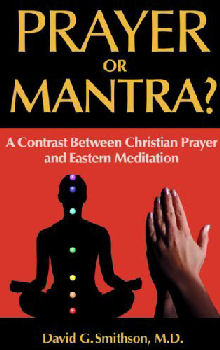
|
Posted May 1, 2006
Book: Prayer or Mantra?: The Contrast Between Christian Prayer and Eastern Meditation Author: David G. Smithson Seven-Three Publications, Shawnee Mission, KS, 2006, pp.84 An Excerpt from the Jacket:
It is with these intriguing questions that David Smithson begins a thought-provoking examination of the contrasts and connections between Christian prayer and eastern meditation. In Prayer or Mantra? A Contrast Between Christian Prayer and Eastern Meditation, Smithson — a physician in the field of physical medicine and rehabilitation — delivers not a definitive treatise on meditation and prayer, but an enthralling book that will challenge readers to consider a new way of connecting scientific findings to spiritual concepts. In this deftly written text, you’ll discover: – The newly emerging discipline of neurotheology, which examines the origins of spiritual experiences within the brain. – What happens when one prays in the Christian sense versus meditating in the eastern sense. – How the issues of “personhood” is a critical point of differentiation between Christian and eastern views. – If prayer and meditation are actually good for one’s health. – What events brought about the eastern invasion of transcendental meditation in the 1960s. – Whether eastern meditation is actually a type of “high”. – The relationship of Christian meditation to Christian prayer. An Excerpt from the Book: What is personhood? Let’s simply define it for our purposes as an individual’s sense of self, of uniqueness. So what does this issue of personhood have to do with our ongoing contrast between Christian prayer and eastern meditation? As we shall see, it is an important concept and defines one of the key differences between the two approaches. Christian prayer itself involves a personal relationship with God; the sense of person or personhood is maintained by the one praying. The uniqueness and individuality of the person praying remains intact during the prayer, as does the personal nature of God. This personhood remains distinct and intact even after death, within the Christian concept of the afterlife. This is not the case with the classic eastern theology of pantheism, however. God is in everything: water, sand, trees, etc. But the personhood of each individual is not included in the end. The uniqueness, the individuality of each person, ends up being only transitory. I would partially relate this to the eastern concept of reincarnation. How can the personhood of each individual remain within the ongoing cycle of death and rebirth as someone or something else? The Buddha himself was noted to have more than 100,000 previous lives. Nirvana could even be seen as a release (and a relief) from the ongoing wheel of existence but at the cost of one’s individuality. Let’s review another quote from Buddha, The Gospel to expand on this. I have italicized two specific phrases in this quotation for emphasis: All compound things shall be dissolved again, worlds will break to pieces and our individualities will be scattered; but the words of Buddha will remain forever. The extinction of self is salvation; the annihilation of self is the condition of enlightenment; the blotting out of self if Nirvana. If we revert to the meditation model from chapter three, we can discuss this issue of personhood further. Within the meditation model we noted that at the peak of eastern meditation both orientation areas of the brain go dark. This includes the left orientation area, which provides the sense of self, and the right orientation area, which provides the sense of space. During this peak of eastern meditation, the left orientation area is not able to find its sense of self — its self would in essence become limitless. Likewise, the right orientation area is not able to find its sense of space – it would, in essence, become spaceless or convey a sense of the infinite. Without the sense of self and devoid of the sense of space, how does on maintain personhood? One could consider it a pursuit in the act of becoming nothing, a nonperson to join the void. It is this issue of personhood that I feel troubles most westerners regarding this eastern emphasis. It just doesn’t feel “right.” Why? Because thre is such a premium placed on individuality and uniqueness in the west. To give this all up is contrary to the way most westerns think. And with Christianity, as we have noted, this sense of retained personhood, this unique ongoing personal relationship with God, is one of its core teachings. Table of Contents: 1. Starting the journey 2. Mind and body 3. The meditation model 4. Crossing the bridge 5. On the other side 6. Personhood – a key difference 7. The Eastern invasion of the West 8. The Eastern invasion repackaged 9. Just another “high”? 10. Spiritual combat 11. The supernatural flight |
|
